The day after the dog sledge tour I drove to the airport and flew for a day trip to Greenland. I have been in Greenland half a decade ago, but then I had been in West-Greenland, while now it was a village in East-Greenland. It was also a rather typical tourist tour, where you fly there, spend a couple of hours there with a tour guide and fly back again.
The weather was great when we flew in, cloudless skies and all that, so there was a great view of the open see and the icebergs swimming in it.
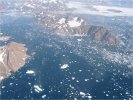
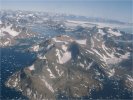
Kulusuk is a small village, about a mile from the airport. Basically the tourist tour includes a slow walk to the village, some local sightseeing of the church and the souvenir shop, a folkloristic 'drum dance' presentation and a semi-optional boat tour back to the airport. I asked the tourguide whether there was any stringent requirement to stay in the group, and he said no, so I could walk around on my own. Since I was more interested in icebergs, the bay and the scenery and less in quaint ethnic follkways, I took the straight route across the hill to the village and photographed some dogs.

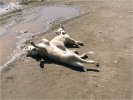
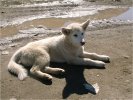

So when the rest group arrived, I climbed town the rocks to the water level So I was out of sight from the village and I more or less wedged myself in between to rocks and looked over the bay. The weather was great, so for the next half hour or so, I just sat there and took in the scenery. If you got the ice-filled bay before you, the sun shining, the mountains and glaciers in the distance, it is easy to ignore the village and the world behind you and pretend that you are alone in a perfect world of serenity.
What made the sight perfect was the sight of a whale swimming lazily among the icebergs. While I had seen a whale only a couple of days before, that was on a specific whale watching tour and expected, but sitting here on the coast, not expecting it at all, was something completely different. Somehow even the whale was different. While the whale during the whale watching tour came up only for a short moment and then went down rather steeply, so you could only see its back as a small, fairly round thing, this whale was more 'stretched'. I assume that is because that whale near Husavik was hunting for plankton and just came up for air an then went straight down again, while this one was just 'swimming around', so it stayed visible for a longer time.
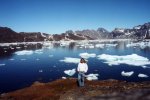
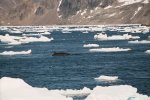
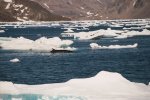
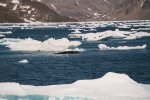
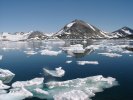
Some more looking at the scenery after that and then it was time to go to the boats. That tour also turned out much nicer than expected, since they don't have any large tourist boats, but only smaller boats with outboard motors So there were only two or three tourists in each boat and it's nice to be able to get really close to the icebergs (which were a smaller than the ones in West-Greenland, so they were unlikely to roll over you).
Interesting experience getting close to the icebergs.
I just happen to like Icebergs.
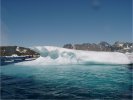
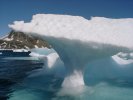
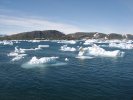
Then it was back onto the airplane and it was time for another surprise. The pilot announced (this was a normal, scheduled flight, btw, not a 'tourist only' or chartered flight): "Since the weather is unusually good we won't fly directly back to Iceland, but we'll fly a bit towards the interior of Greenland, make a turn over the glaciers and then proceed towards Iceland. It'll make our flight about twenty minutes longer. I hope you don't mind."
I've seen planes delayed by bad weather, but this was the first time that I've been on a plane that was delayed because the weather was too good.
Adding luck to convenience, I had a window seat, so I did get a good view (and some nice pictures) of the glaciers in Greenland. After the dog sledge tour in Iceland, that was the second best day I had on that vacation (third best day was at the iceberg lagoon three days earlier).
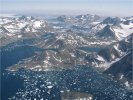
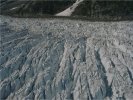
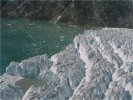


And when I got back to the airport, the rental car was still undamaged. (Yes, that's not really noteworthy, but after two broken cars, I was getting careful.) I drove back to the hotel, where the rental agency was going to pick it during the night. So at least the third car made it back undamaged to the rental agency.
The next day tour was to the Vestmannaeyjar islands, a group of small islands a bit off the coast of Iceland.
The islands are all quite small. The largest one is about two miles by three miles in size, the other ones are smaller than a quarter mile in each direction. The airport on the largest Island runs almost from coast to coast, leaving just a small gap at the end for the street to go through.
If you're there for a day you can walk avery see every bit of street they have. On foot. Twice.
After landing on the airport, there was a short bus tour, on which the only really interesting bit was a puffin colony.
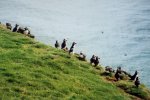
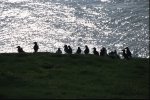
That was followed by a boat tour around the main island. It takes about one hour to circle the whole island with ample time for detours. Surprisingly, it was fun. The coast is quite rugged with lots of cliffs, holes, caves, odd edges and formations. (Like a big rock that looks a lot like an elephant head.) It's also quite colourful in places, due to various kinds of fungi and mosses that live quite well on the fertilization due to the bird colonies (lots of birds on the cliffs). Strange highlight: Near the end of the tour the captain of the cruise boat steered the ship into one of the big caves, positioned the boat carefully in the middle of it, turned off the engines and started playing his saxophone to demonstrate the acoustics of the cave. I guess that steering a tourist ship gets too boring after a while if you can't show off a bit.
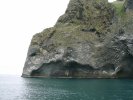
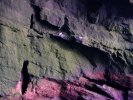
After the boat tour I had a couple of hours to walk around on my own, so I walked to the main attraction, which is a mountain called Eldfell. (Well, more like a large hill.)
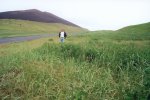
And the mountain is relevant because... well, I'm older than it.
It's another case of 'geography while you wait' in Iceland. The island of Heimaey was even smaller in 1973 until a a fissure erupted on the island and lava started flowing out of it. Lava kept flowing for five months, and after that the island was 15% larger and had an additional mountain.
So that was the part of the trip where I felt really, really old. Besides being awfully young for a mountain, the place has a rather unfinished feel to it. While it's not dangerous any more (ok, not more dangerous than any other part of Iceland that might blow up any minute, but that doesn't count), it's still warm. There's no actual lava involved anymore, though. It's another non-typical icelandic non-volcano. The fissure was at ground level and it kept spewing lava in the air, which turned into volcanic ash and got blown away by the wind and heaped on to build the mountain. (A bit like sand blown around and creating a dune, just on a larger scale.) So the original fissure is beside the mountain, and the mountain has no lava vent and is just a big pile of small rocks.
But the volcanic ash was still hot, and since it solidified in the air, it has lots of air bubbles inside and is a very good isolator. So good, that only they very surface of the mountain has cooled down. If you climb the mountain (which is not so easy, since it's basically a just pile of loose rubble) and dig a bit in the ground (which is easy, since it's basically just a pile of loose rubble), the ground gets warm. Dig a bit further and the ground gets very warm. Dig deeper and you wish you'd brought a shovel...
About ten inches downward you get about 120F. They measure the temperature regularily and at about one yard depth the temperature is 1500F, so one shouldn't dig too deeply. I didn't have time for that, but you can buy metal boxes and put bread dough in it and bury it underground, dig it out the next day and have naturally baked bread. The athmosphere there is a bit eerie, since there's always steam coming out of the ground.
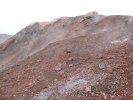
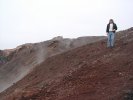
It's also interesting to see, how a mountain looks before erosion has its go on geography. At the parts where the rocks have 'baked together', they are very rough and edgy.


If you want to see how it will look after a while, take a look at the next image with the greenish looking mountain on it. If I'd be a geology teacher on a field trip, I would use the words "we don't want to wait, so here's one I prepared earlier". The green one is Helgafell and it was build by basically the same process as Eldfell, just about 5000 years earlier (still young for a mountain, but at least that one is older than me ;-)
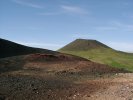
One more look over some other Vestmannaejar islands (and Iceland in the background) and it was time to fly back to Reykjavik again.
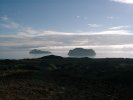
The next day tour to Höfn, a small town in south Iceland, the starting point for a bus tour up to Vatnajökull glacier. When we came to the glacier ice, it was time to change into thermo-suits and onto the snowmobiles. A snowmobile tour on the largest glacier in Europe. Fun.
It's a great view in good weather, a vast expanse of white with a couple of black mountaintops in between to give the place structure and depth. And I like riding snowmobiles, even though it was in a rather large group and we had to drive single-file, which dampens the fun a bit. But it was possible to drive slowly, hang back a bit, and then drive a lot faster for a short while.
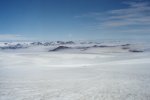

Once again it was interesting how fast the weather changed. If you take a look at the images above, it's mostly blue skies, with a couple of minor clouds and a couple of foggy patches on the glacier. When we came back from the tour (about 20 minutes later), we were driving through dense fog and you couldn't actually follow the snowmobile in front of you (about ten yards ahead), but you had to follow the tracks in the snow instead.
Unfortunatly the weather remained like that for the end of the day. After the snowmobile trip there was lunch and another bus tour down to the iceberg lagoon (which I had seen before) and the generic one hour tourist stop, with 30 minutes for the tour across the lake in the amphibious boats and the rest of the time for buying postcards.
As can be deduced from the lack of pictures, it wasn't as exciting as it was on the sunny day a week earlier. I was quite happy that I had spent the full day at the lagoon (and did do the boat trip) when the weather was good and hadn't skipped it because I knew I would be back later. After that it was back to the airport and from there back to Reykjavik.
Snowmobiles and icebergs make a perfect vacation day for me, but at that point in the vacation I had done so many things and taking so many pictures of icebergs that I didn't take too many pictures, so the two images above have to be sufficient.
Next morning it was off to the airport again, the fourth day trip per plane in as many days, heading to the Faroe Islands for a two-day vacation within the vacation.
I mainly wanted to go there, since I was unlikely to happen to be in the vicinity of it again and if I wouldn't go there during this vacation, I probably never would. t was more a 'completeness' thing to visit the Faroes than anything else.
And my main travel guidebook for this trip was my trusty "Iceland, Greenland and the Faroe Islands" and I was going to go to Iceland and Greenland anyway, so it just seemed fitting to use all of the book and make this vacation "Iceland, Greenland and the Faroe Islands" as well.
It's about two hours flight time from Iceland, and while you can make a day trip to the Faroes on one day of the week (the flight connections are a bit irregular and there's only one specific day where there are two flights and you can fly in, sightsee and fly out again). But I wanted a bit of time to look around, so I did make a two day trip.
Which was a day too long.
The problem with the Faroe Islands is that it is a pleasant place.
When you fly in, you see nice picturesque islands, mostly gentle slopes, with just a few steep bird cliffs on the side. All covered in a beautiful, uniform, lush green vegetation, with sheeps grazing quitely all over the place. (Yes, yet another miniature Scotland...)
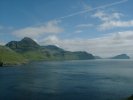
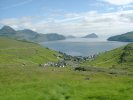
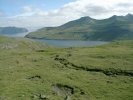
And then you get in the bus and drive to the ferry and you seen lush green vegetation, sheeps peacefully grazing, gentle, rolling slopes...
And then you get onto the ferry to get over to the main island and you can already see that it's green, gently sloped...
And then you get into the bus again to drive over to the capital of the Faroes and you notice that the while island is pleasant to look at, being green, with nice, gentle hills...
All very nice, all very beautiful, and it drove me to terminal boredom within an hour.
The name 'Faroes' means 'islands of sheep' and you get the distinct impression that the first cloning attempt wasn't done with a sheep, but with an island of sheep. All of the Faroes islands seem to look the same. Very nice, very photogenic, very... (you get the general idea by now), but basically you can take a five minute look, see what the place looks like and go away again. If you want to have a panoramic photograph of the Faroes, just take a picture anywhere, make a thousand copies, stick them side by side and you have a valid represenation of the place.
I don't want to say anything against the Faroe Islands, because they are actually a very nice place, but when I reached the Torshavn (the capitol), I had no idea what to do with the rest of the day. Yes, I could walk around and take a look at the nice, green scenery. Again. But I've been there, done that and had nothing else to do.
Ok, ok, I'm being a bit frustrated here, but the problem with a place that's a bit off the touristic paths is sometimes that there's little to do touristically. Some travel guide said that it would take a week to see all the interesting sights on the Faroes. I think they were rather cynical. It does take a week to do all the touristic things you can do, but that's because they are scheduled that way. So it's only possible to see the bird cliffs on Monday, the only tour to the old coal mines is on Tuesday, the guided walk to the historical village is on Wednesday, and so on. Unfortunatly I had already missed the bird cliff tour and on the next day, there was only a full day tour available, which I couldn't take because I had to catch the plane back to Iceland. So I couldn't even do anything touristical. The only thing I could do was walk around the capital and kill time.
About an hour.
Torshavn is arguably the smallest capital in the world (with 16000 inhabitants), so seeing all of Torshavn doesn't take particularily long. The only good thing about the town is that they seem to have received a lot of arts grants for statues. There's about a statue standing around at every corner and most of them are fairly neat and original. I especially liked the dragon fight done Tiffany-style.

Next day I walked around Thorshavn (again), took a look (again) at the old grass roof houses at the harbour and the old danish fort overlooking the harbour.

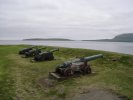
So I killed some more time, took the bus to the airport in the afternoon and went back to Iceland. So at least I can say I have been to the Faroes. But unless you like long walks over lush, green, grassy hills, you won't find many reasons to go there.
The last day tour in Iceland was a jeep tour to Landmannalaugar. Partly, because I had done most other interesting things, partly, because I wanted to get home in one piece (there was also the possibility to have a day tour riding Icelandic horses, but I didn't want to push my luck), but mostly, because it had been on my schedule and I missed out on it.
When I still had the rented car, my route was supposed to go through the Landmannlaugar area after I got down the Sprenginsandur track. But since the car got damaged I didn't want to drive it along any more tracks than necessary, so I took the long way along the ring road instead of taking the direct way through. Especially, since there were a significant number of river crossings on that way and I had enough of those.
There is a company offering jeep tours to that area, so I decided to take one of these and 'cross off' another sight from the list of 'places to see in Iceland'. Also, since it was a jeep tour, it wasn't a mass tourism thing like the trip to Höfn, but a nice, small tour.
First stop was, this being Iceland, yet another waterfall. Quite nice, clear water, interesting rock formations on the side, nobody there but out jeep. But after almost three weeks in Iceland, for me it was mostly "oh, another waterfall".

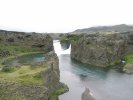
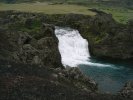
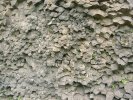
On to Stöng, which is a reconstruction of an old medieval farm. Nicely green, since they didn't have much wood when the original farm was build around 900, so they used timber only for the entrance of the chapel and the large beam holding up the roof, but otherwise used mainly grass for building. Which seems a bit surprising, since there are rocks in abundance, so I would have expected a stone building. But they just used some rocks as the foundation and then used sheets of grassy ground and piled them in patterbs to build thick (about a yard) grass/earth walls. Which actually makes sense considering the weather conditions (in winter, stone walls would be very cold), but was unexpected. Good place for a short stop. Not something I would like to visit with a bus tour (there was one coming up as we left), but in a small group, it was interesting. (Btw, they knew a lot about how to re-build an medieval farm, since the original Stöng farm is a couple of miles away and was covered by volcanic ash after an eruption of Hekla more than a thousand years ago. They have just recently dug it out and reconstructed the farm according to what was found on the original one.)
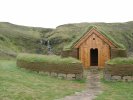
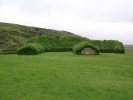
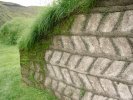
Next stops were two more waterfalls, but this time more unusual ones, so that even I (jaded as I was :-) had to admit they they were impressive.
The first one was a good candidate for any Shangri-La or lost world scenario (without dinosaurs, though). After driving through a rather nondescript area for a while, we came to a small, very photogenic valley, with two waterfalls tumbling down into it, leading into a stream that cascades through the valley. A small rocky hill, two-thirds surrounded by the stream, a natural arch leading to a natural platform, overlooking thick, green vegetations. Very idyllic.
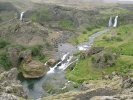
And a while later, one of these rows of waterfalls that seem to come from nowhere. A bit further along is a lake and the rocks are so porous that water leaks out sidewards from the lake and tumbles down into the first gorge it encounters, producing a series of waterfalls with no river attached to the upper end. Sort of a Grand Canyon wannabe with water on the sides.
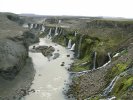
Then it was on to Landmannalaugar, passing another caldera (looking like a volcano, but probably not being one), and an centuries old lava stream, passing between two hills and running into a lake, which was only interesting, because two remaining bits of snow at one of the hills made the hill look like the face of an orang-utan (which doesn't show up too well on the pictures, but looked neat in reality).
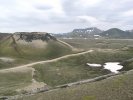
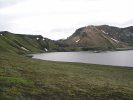
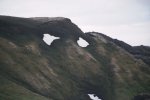
Then we came to Landmannalaugar itself, which was a bit of a let-down. While I can see why travel guides praise it at length, it left me a bit cold due to cloudy weather. And tourists.
As for the cloudy weather: Landmannalaugar is best known for being very colourful. There are lots of different minerals in the hills in this area, so you get peaks and streaks in all colours, from red to orange to green to even a deep blue. If you stand there on an overcast day, you can easily imagine how great it must look on a sunny day, when the colours shine brightly, but on a not-so-fine day, it's just murky shades. A fine area, regardless, but it's just too easy to get an idea how it could look like, and the actual look is pale by comparision.
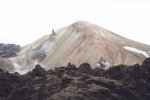
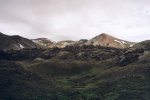
As for the tourists: Landmannalaugar itself is full of them. While all the attractions on the way are relativly empty (our jeep driver was very good in keeping out of the way of the tour busses, approaching attractions from odd roads and generally finding small places of interest that are too small for mass tourism, but nice to look at), but Landmannalaugar itself is a large bus stop and camping site, so it's pretty crowded. Which doesn't matter too much, since it's a large area, but unfortunatly the main attraction is quite small.
At Landmannalaugar, two small streams converge. One coming from an geothermally active area, one not. Which means that one of the streams is quite hot (about 150 F), while the other is cold (probably 50 F or so). In the area where they mix, you can select your favourite bathing temperature by moving a couple of inches. Natural hot and cold water bathtub. Great!
The problem is only that the 'bathable area' is about the size of a large whirlpool, about 10 feet diameter. So when 20 people try this natural bathtub, it gets a bit crowded. And only half a dozen of them get any kind of decent temperature, the rest gets cold or cooked.
Which was still ok, since I happened to get in when a group of people just left, so I got a comfortably warm place to be in (the water is only about a foot deep, so you have to lie low). I was in there with only five people for about ten minutes before another group of two dozen people splashed in. Which was also ok. (I was there as a tourist at one of the main attractions, so how can I complain about other tourists doing the same?)
But: What was really annoying was the rest of the busload of people, who were standing in a long row along the path and taking pictures. While there were also people making pictures at my other hot bath in the Askja crater, that was sort of surrealistic, being there in the warm water and seeing the windswept people up on the rim of the crater looking bewildered down. But here it was more like trying to take a short bath and 50 paparazzi clicking away with their cameras. It was just no fun. This was really a horde of tourists, engaging in crowd behaviour. Plain annoying.
And a pity. If you stay there overnight (which probably still means that there are 50 other people around you, let's just ignore that for a moment), and sit there in the warm water, looking at the sun going down behind the mountains, the last rays sparkling over the mountains - it's probably the greatest moment you can have in Iceland (except for going dog sledding, but that's probably just me). But sitting there in front of 50 people, who don't even join the fun but just stand there and make meaningless pictures (because they don't show anything except people taking a bath in a stream; you can't see the two different temperatures running into it, you can only experience it) was depressing.
After the Landmannalaugar stop we continued to some smaller and quiter places, like a small cave with some colourful lichen in it and some small lakes and stuff like that. Good places for a small tour like this. Not big attractions, but things worth noticing.
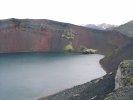
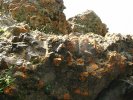
On the way back, we once again passed a rather greyish area. Earlier in the year (about three months earlier) the volcano Hekla had erupted (which it does from time to time). So the landscape around it, especially downwind, was covered with small greyish rocks (volcanic ash) for miles and miles. For a minute or so, we could even see mount Hekla itself. (Which is uncommon, since "thanks to the almost perpetual bank of cloud that shrouds it, visitors will be lucky to see Hekla".) Hekla was quite friendly in that respect. We reached the grey ash, had a short stop, looked for Hekla amidst the clouds, the clouds moved aside for a minute or so, we took our pictures, the clouds moved in again and the show was over for today. We got back into the car and five minutes later it started to rain, but since that was the last stop before we got back to Reykjavik, we didn't mind.

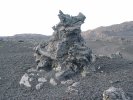
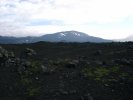
And that was about it. I had one more day before I had to fly back to Germany, and I spent that day walking around in Reykjavik, looking at the shops, landmarks and art exhibits. Reykjavik was one of 'Europes cultural capitals 2000' and they had a number of art activites to go with it, one of them being a 'culture coastline'. Which was basically two dozen pieces of artwork along the coast, so it was a nice long walk with interesting things.
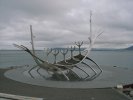
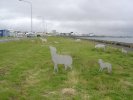
Otherwise Reykjavik is ok, but little more. Nice city, some good shops, one large shopping mall, a few large parks, but nothing really exciting, though.
The best bit of Reykjavik is probably the 'Perlan' (no points for guessing that this means pearl). Basically it's just the water reservoir, but on top of it they have build a semi-sphere with a coffee shop and a restaurant, which is expensive even by Reykjavik standards. You can walk around the sphere and it is a great view over all of Reykyavik and surroundings, which makes going there a must.
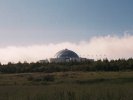
And that's it. A couple of scary moments (two damaged rental cars), a couple of great moments (dog sledding on a glacier, seeing a whale among the icebergs at the Greenlandic coast, standing on a mountain younger then me, cruising among the icebergs in the sun, snowmobiling on Europe's largest glacier, bathing in a still warm crater). Some disappointments (the interior tracks, driving an off-road vehicle), a couple of great places (þingvellir, Myvatn lake, Askja). An interesting mix of things. Not as straight forward as some other vacations, more like a roller-coaster ride, but, in retrospect, a great vacation.